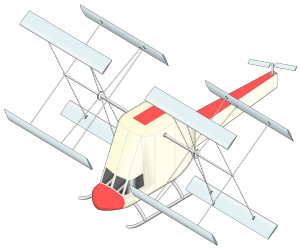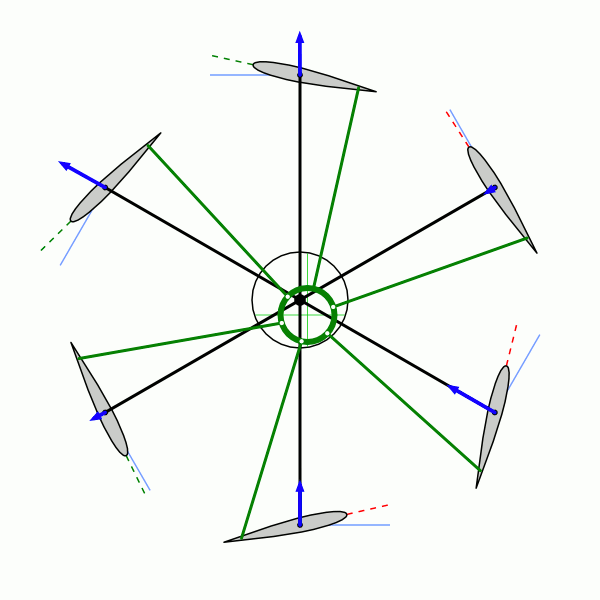
Cyclogyro
Encyclopedia

Aircraft
An aircraft is a vehicle that is able to fly by gaining support from the air, or, in general, the atmosphere of a planet. An aircraft counters the force of gravity by using either static lift or by using the dynamic lift of an airfoil, or in a few cases the downward thrust from jet engines.Although...
design that uses Cycloidal Rotors which consist of airfoil
Airfoil
An airfoil or aerofoil is the shape of a wing or blade or sail as seen in cross-section....
s rotating around a horizontal axis for both lift and thrust. They are capable of vertical take off and landing
VTOL
A vertical take-off and landing aircraft is one that can hover, take off and land vertically. This classification includes fixed-wing aircraft as well as helicopters and other aircraft with powered rotors, such as cyclogyros/cyclocopters and tiltrotors...
and hovering performance like a helicopter
Helicopter
A helicopter is a type of rotorcraft in which lift and thrust are supplied by one or more engine-driven rotors. This allows the helicopter to take off and land vertically, to hover, and to fly forwards, backwards, and laterally...
, but do not suffer from the helicopter's very low efficiency in forward flight (meaning very high power/fuel requirements and limited flight range compared to the airplanes), low forward speed, very high noise and vibration levels and low altitude ceiling. Although a number of cyclogyros were built in the 1930s, none was known to have successfully flown until 2011. The cyclogyro could be mistaken for different aircraft designs using cylindrical wings, which attempted to harness the Magnus effect
Magnus effect
The Magnus effect is the phenomenon whereby a spinning object flying in a fluid creates a whirlpool of fluid around itself, and experiences a force perpendicular to the line of motion...
. However, those were unrelated aerodynamically and were unsuccessful.
Function

Paddle wheel
A paddle wheel is a waterwheel in which a number of scoops are set around the periphery of the wheel. It has several usages.* Very low lift water pumping, such as flooding paddy fields at no more than about height above the water source....
, with airfoils replacing the paddles. The airfoils'pitch (angle of attack) is adjusted either collectively by means of a control ring with links to all blades, which is located eccentrically and variably relative to the rotor's axis of rotation or the blades are individually adjustable in pitch and are adjusted continually by the control system as they move around the rotor's axis. In normal forward flight the airfoils are given a slight positive pitch at the upper and forward portions of their arc, producing lift and forward thrust. They are given flat or negative pitch at the bottom, and are "flat" through the rest of the circle to produce little or no lift in other directions. The pitch can be adjusted to change the thrust profile, allowing the cyclogyro to travel in any direction. Differential thrust between the two wings (one on either side of the fuselage) can be used to turn the aircraft around its vertical axis, although conventional tail surfaces are generally used as well.
History
Jonathan Edward CaldwellJonathan Edward Caldwell
Jonathan Edward Caldwell was a self-taught aeronautical engineer who designed a series of bizarre aircraft and started public companies in order to finance their construction. None of these was ever successful, and after his last known attempt in the later 1930s he disappeared, apparently to avoid...
appears to have been the first to patent the concept, and invent the term. He filed a patent on the concept that was granted in 1927, but immediately moved on to an ornithopter
Ornithopter
An ornithopter is an aircraft that flies by flapping its wings. Designers seek to imitate the flapping-wing flight of birds, bats, and insects. Though machines may differ in form, they are usually built on the same scale as these flying creatures. Manned ornithopters have also been built, and some...
design and appears to have made no effort to build a cyclogyro of his own. Several attempts to build a working cyclogyro were made by other designers. The earliest full-sized example appears to be the Schroeder S1 from 1930, which used the cyclogyro "wheels" for forward thrust only. Adolf Rohrbach of Germany designed a full VTOL version in 1933, which was later developed in the US and featured a tall fish-like fuselage to keep the wings well clear of the ground. Another example is the Rahn Aircraft version from 1935, which used two much larger chord wings instead of a multi-blade wheel.
In 1935 NACA
NACA
- Organizations :* National Advisory Committee for Aeronautics, the forerunner of the U.S. federal agency NASA* National Association for Campus Activities, an organization for programmers of university and college activities...
carried out a series of wind tunnel
Wind tunnel
A wind tunnel is a research tool used in aerodynamic research to study the effects of air moving past solid objects.-Theory of operation:Wind tunnels were first proposed as a means of studying vehicles in free flight...
experiments on the cyclogyro concept, and found that the power required to turn the wheels was much higher than expected. Theoretical tools of the era simply weren't useful for prediction on the highly asymmetrical lift profiles and the greatly simplified models they used varied dramatically from real-world results. Early experiments then ended.
The concept has experienced a renaissance in the recent years due to the promise of much higher efficiency and quiet operation, as well as the availability of lighter materials, control systems and the improved understanding of the aerodynamics of its operation. One line of inquiry has been smaller UAV
Unmanned aerial vehicle
An unmanned aerial vehicle , also known as a unmanned aircraft system , remotely piloted aircraft or unmanned aircraft, is a machine which functions either by the remote control of a navigator or pilot or autonomously, that is, as a self-directing entity...
designs, where the hovering capability would be particularly useful. These have been successful, with 2 examples that have flown successfully, one tethered in 2007 and one impressively agile, free flying in 2011.
Modern uses
A team at the University of Singapore built a working model of cyclogyro in 2007, although it has only flown in tethered flight. Their cycloidal model was a modified helicopter, with the rotorHelicopter rotor
A helicopter main rotor or rotor system is a type of fan that is used to generate both the aerodynamic lift force that supports the weight of the helicopter, and thrust which counteracts aerodynamic drag in forward flight...
replaced with two sideways cycloidal rotors, each with three blades sticking out of them in the perpendicular.
Subsequently Dr. Hu from the Singapore team moved to Northwestern Polytechnic University in China and there the team that he headed has built a free flying and precisely controlled Cyclogyro (Cyclocopter) which is a major development amounting to the beginning of the end for the Helicopters.They used 2 cycloidal rotors for the efficient generation of lift and the small and noisy conventional head and tail rotors to stabilize the craft and provide control of its horizontal position and the direction of flight. Videos of its flights are readily findable on youtube: Test Flight of cyclogyro.flv
The Austrian company Innovative Aerodynamic Technologies (IAT) premiered a 4 rotor cyclogyro at the Paris Air Show in June 2011. IAT has christened their creation Project D-DALUS. The company's website describes the prototype as follows:
"The propulsion consists of 4 sets of contra-rotating disks, each set driven at the same rpm by a conventional aero-engine. The disks are surrounded by blades whose angle of attack can be altered by off-setting the axis of the rotating disks. As each blade can be given a different angle of attack, the resulting main thrust can be in any required direction in 360° around any axis. This allows the craft to launch vertically, remain in a fixed position in the air, travel in any direction, rotate in any direction, and thrust upwards thereby ‘gluing down’ on landing."
Modern technology allows not only for many of the obstacles facing a 20th century cyclogyro developer to be easily overcome, but created the possibilities for the revolutionary further improvements of this concept. For example the concept of a variable cycloidal rotor has been developed where the blades are to travel about the horizontal axis along the most aerodynamically desirable orbit as continuously determined by the control system which will generally be non-circular and elongated, with that orbit shape dynamically modified by the control system as the flight regime and conditions change to keep the relative airflow about the blades optimized. The dynamic counterbalancing of the blades radial movements is used to keep the rotor balanced. The variable cycloidal rotors can be expected to reach much higher levels of efficiency compared to the circular orbiting rotors, but their operation and the blade orbit shape could alternatively be optimized for the highest flight speed or the highest possible lifting capability. Rapid and precise changes to the "wing" configuration can be accomplished by microprocessors, as the new materials such as for example carbon nanotube based materials are very much lighter and stronger and also due to their ability to contract when voltage is applied can be more precisely adapted to the needs of a cyclogyro developer today. Given the rapid progress accomplished in the field lately and the much greater opportunities for further development it can be seen that not only are the cyclogyros (cyclocopters) headed to become the dominant type of the vertical takeoff and landing air vehicle, but they can reasonably be expected to take a substantial market share from the fixed wing aircraft (requiring very costly and usually remote airports) which today still comprise 90% of all aircraft in operation, thereby reshaping the aviation industry.
Further reading
- "The Cyclogyro", Vertiflight, The American Helicopter Society, 2005, Vol. 51; No. 2, pages 16-19

